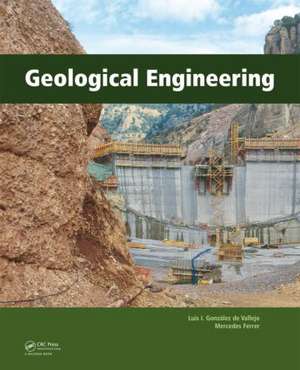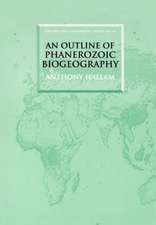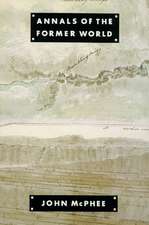Geological Engineering
Autor Luis Gonzalez de Vallejo, Mercedes Ferreren Limba Engleză Hardback – 12 ian 2011
Geological Engineering provides an interpretation of the geological setting, integrating geological conditions into engineering design and construction, and provides engineering solutions that take into account both ground conditions and environment.
This textbook, extensively illustrated with working examples and a wealth of graphics, covers the subject area of geological engineering in four sections:
- Fundamentals: soil mechanics, rock mechanics and hydrogeology
- Methods: site investigations, rock mass characterization and engineering geological mapping
- Applications: foundations, slope stability, tunnelling, dams and reservoirs and earth works
- Geohazards: landslides, other mass movements, earthquake hazards and prevention and mitigation of geological hazards
Preț: 934.74 lei
Preț vechi: 1139.93 lei
-18% Nou
Puncte Express: 1402
Preț estimativ în valută:
178.86€ • 186.74$ • 148.03£
178.86€ • 186.74$ • 148.03£
Carte tipărită la comandă
Livrare economică 05-19 aprilie
Preluare comenzi: 021 569.72.76
Specificații
ISBN-13: 9780415413527
ISBN-10: 0415413524
Pagini: 700
Ilustrații: 500 colour illustrations, 150 colour tables, 250 colour illustrations
Dimensiuni: 219 x 276 x 33 mm
Greutate: 1.7 kg
Ediția:1
Editura: CRC Press
Colecția CRC Press
ISBN-10: 0415413524
Pagini: 700
Ilustrații: 500 colour illustrations, 150 colour tables, 250 colour illustrations
Dimensiuni: 219 x 276 x 33 mm
Greutate: 1.7 kg
Ediția:1
Editura: CRC Press
Colecția CRC Press
Public țintă
Postgraduate and ProfessionalCuprins
Fundamentals: Introduction to Geological Engineering. Soil Mechanics and Engineering Geology of Sediments. Rock Mechanics. Hydrogeology. Methods: Site Investigation. Rock Mass Description and Characterisation. Engineering Geological Mapping. Applications: Foundations. Slopes. Tunnels. Dams and Reservoirs. Earth Structures. Geological Hazards: Landslides and Other Mass Movements. Seismic Hazard. Prevention of Geological Hazards.
Notă biografică
Luis I. González de Vallejo; Professor of Geological Engineering at the Complutense University of Madrid, where he is also Director of the MSc Courses in Geological Engineering. He has dedicated his professional career in geological engineering to consulting, research and teaching, and he has conducted a large number of geological and geotechnical investigations for the design and construction of tunnels, dams and foundations in Spain and Central and South America, including landslide and earthquake hazard analysis, large excavations and site assessment for nuclear power plants and radioactive waste disposal.
He has written over 120 papers in journals and proceedings as well as five books. Associate Editor of Soils and Rocks and Member of the Editorial Board of several scientific journals, he has been invited to present the 2nd Mariano Ruiz Vazquez Lecture, at the Academy of Engineering of Mexico, in 2007, and the XXVII Manuel Rocha Lecture, at the Portuguese Geotechnical Society, in 2010.
Mercedes Ferrer; Senior Research Officer at the Geological Survey of Spain and Associate Lecturer on Rock Mechanics at the Complutense University of Madrid, where she graduated in Geological Sciences and obtained her doctorate for her research on the deformability and failure mechanisms of soft rocks. She has carried out research projects on geological hazards in Spain, Italy and Central and South America, particularly on landslides and geo-hazard mapping for urban planning, mitigation and prevention purposes.
She has written over 100 papers and research reports on geological hazards, landslides and slope stability. At present she is leading a research project on the causes and failure mechanisms of the mega-rockslides of volcanic islands flanks.
He has written over 120 papers in journals and proceedings as well as five books. Associate Editor of Soils and Rocks and Member of the Editorial Board of several scientific journals, he has been invited to present the 2nd Mariano Ruiz Vazquez Lecture, at the Academy of Engineering of Mexico, in 2007, and the XXVII Manuel Rocha Lecture, at the Portuguese Geotechnical Society, in 2010.
Mercedes Ferrer; Senior Research Officer at the Geological Survey of Spain and Associate Lecturer on Rock Mechanics at the Complutense University of Madrid, where she graduated in Geological Sciences and obtained her doctorate for her research on the deformability and failure mechanisms of soft rocks. She has carried out research projects on geological hazards in Spain, Italy and Central and South America, particularly on landslides and geo-hazard mapping for urban planning, mitigation and prevention purposes.
She has written over 100 papers and research reports on geological hazards, landslides and slope stability. At present she is leading a research project on the causes and failure mechanisms of the mega-rockslides of volcanic islands flanks.
Recenzii
Looking through the book and thinking of the huge effort required to obtain all the information, followed by processing it so that the ideas and data can be presented with such clarity, and then to actually write the book and prepare the self-explanatory diagrams is truly more than impressive: it is an outstanding achievement. Another excellent feature is that it is simultaneously an undergraduate, post-graduate, and practical book.
—John A. Hudson, Emeritus Professor, Imperial College, UK; Past-President, International Society for Rock Mechanics, 2007-2011
With Geological Engineering Luis González de Vallejo and Mercedes Ferrer succeeded in offering a standard work, of interest for a wide group of users, in a broad range of geologically differing areas, as a support in the application of geology to research, design and construction in civil engineering.
—Floris Schokking, GeoConsult B.V., Haarlem
This beautifully illustrated text book has everything an engineering geologist and those with a wide interest in civil engineering could wish for. The content of Geological Engineering is a suitable reminder of the huge range of disciplines and engineering problems that are expected to be tackled during the career of experienced international consultants, by international civil engineering design offices, by earth science researchers, and by graduate students starting out in this fascinating but challenging major branch of science and engineering. All the back-ground needed for those engaged in foundations, slopes, tunnels, dams and reservoirs and earth structures can be found here.
Undoubtedly, it is going to prove to be one of the very best broad-reference books for a very large number of educators, geologists, engineering geologists, soil mechanics and rock mechanics specialists, and hydro-geologists. It is truly an impressive production.
Congratulations to the authors, to the editors, and to the producers of this landmark publication.
—Dr. Nick Barton
The many illustrations enable this text to provide a unique means of communication to its readers, unmatched by other texts in the field, because they impart a sense of the scale and variability that have to be addressed when working in the subject. This is a contribution to geotechnical engineering that will support and improve the teaching and application of Engineering Geology for years to come.
—Michael H. de Freitas, Reader Emeritus in Engineering Geology, Imperial College, London, UK
Vallejo and Ferrer (2011) have come forth with a basic book defining the 90-year emerged body of knowledge with which every graduate geological engineer should be familiar.
—Allen W. Hatheway in Environmental & Engineering Geoscience, Vol. XVIII, No. 2, May 2012, pp. 209-215
—John A. Hudson, Emeritus Professor, Imperial College, UK; Past-President, International Society for Rock Mechanics, 2007-2011
With Geological Engineering Luis González de Vallejo and Mercedes Ferrer succeeded in offering a standard work, of interest for a wide group of users, in a broad range of geologically differing areas, as a support in the application of geology to research, design and construction in civil engineering.
—Floris Schokking, GeoConsult B.V., Haarlem
This beautifully illustrated text book has everything an engineering geologist and those with a wide interest in civil engineering could wish for. The content of Geological Engineering is a suitable reminder of the huge range of disciplines and engineering problems that are expected to be tackled during the career of experienced international consultants, by international civil engineering design offices, by earth science researchers, and by graduate students starting out in this fascinating but challenging major branch of science and engineering. All the back-ground needed for those engaged in foundations, slopes, tunnels, dams and reservoirs and earth structures can be found here.
Undoubtedly, it is going to prove to be one of the very best broad-reference books for a very large number of educators, geologists, engineering geologists, soil mechanics and rock mechanics specialists, and hydro-geologists. It is truly an impressive production.
Congratulations to the authors, to the editors, and to the producers of this landmark publication.
—Dr. Nick Barton
The many illustrations enable this text to provide a unique means of communication to its readers, unmatched by other texts in the field, because they impart a sense of the scale and variability that have to be addressed when working in the subject. This is a contribution to geotechnical engineering that will support and improve the teaching and application of Engineering Geology for years to come.
—Michael H. de Freitas, Reader Emeritus in Engineering Geology, Imperial College, London, UK
Vallejo and Ferrer (2011) have come forth with a basic book defining the 90-year emerged body of knowledge with which every graduate geological engineer should be familiar.
—Allen W. Hatheway in Environmental & Engineering Geoscience, Vol. XVIII, No. 2, May 2012, pp. 209-215
Descriere
A guide for developing integrated engineering solutions that take into account both ground conditions and environment, this extensively illustrated textbook examines the subject area of geological engineering in four sections: Fundamentals, Methods, Applications, and Geohazards. Covering topics such as site investigation, rock mechanics, and slope stability, Geological Engineering provides an extensive foundation in the basic concepts of soil mechanics and hydrogeology, while also including state-of-the art applications. In addition to its superb academic features, the book is also useful for practicing engineering geologists and those involved in the design and construction of foundations.















